Research: Recruitment Impact on Organizational Performance in Telecom
VerifiedAdded on 2023/06/11
|36
|11190
|85
Report
AI Summary
This report details the research methodology employed to investigate the impact of recruitment and selection processes on organizational performance within the Moroccan telecom industry. A deductive approach, grounded in positivism, is utilized, incorporating mixed methods such as surveys, questionnaires, and focus groups to gather both primary and secondary data. The study targets HR managers, practitioners, and workers within the telecom sector, analyzing the relationship between independent variables (recruitment and selection policies) and dependent variables (organizational performance). Ethical considerations and access protocols are addressed to ensure confidentiality and compliance. The research aims to establish the effectiveness of HR processes in enhancing organizational growth and productivity, contributing valuable insights for telecom industries in Morocco. Desklib provides access to similar solved assignments and resources for students.
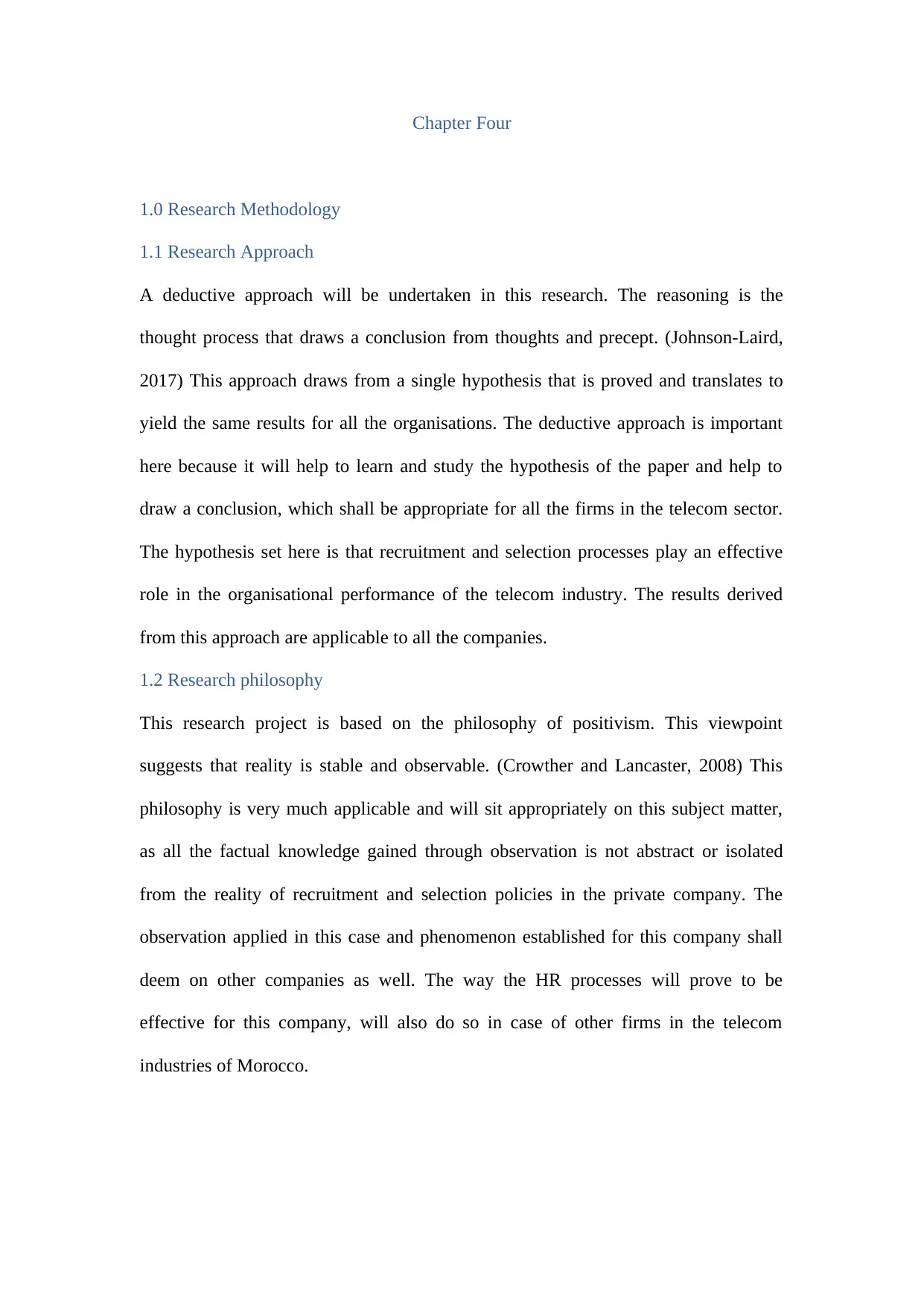
Chapter Four
1.0 Research Methodology
1.1 Research Approach
A deductive approach will be undertaken in this research. The reasoning is the
thought process that draws a conclusion from thoughts and precept. (Johnson-Laird,
2017) This approach draws from a single hypothesis that is proved and translates to
yield the same results for all the organisations. The deductive approach is important
here because it will help to learn and study the hypothesis of the paper and help to
draw a conclusion, which shall be appropriate for all the firms in the telecom sector.
The hypothesis set here is that recruitment and selection processes play an effective
role in the organisational performance of the telecom industry. The results derived
from this approach are applicable to all the companies.
1.2 Research philosophy
This research project is based on the philosophy of positivism. This viewpoint
suggests that reality is stable and observable. (Crowther and Lancaster, 2008) This
philosophy is very much applicable and will sit appropriately on this subject matter,
as all the factual knowledge gained through observation is not abstract or isolated
from the reality of recruitment and selection policies in the private company. The
observation applied in this case and phenomenon established for this company shall
deem on other companies as well. The way the HR processes will prove to be
effective for this company, will also do so in case of other firms in the telecom
industries of Morocco.
1.0 Research Methodology
1.1 Research Approach
A deductive approach will be undertaken in this research. The reasoning is the
thought process that draws a conclusion from thoughts and precept. (Johnson-Laird,
2017) This approach draws from a single hypothesis that is proved and translates to
yield the same results for all the organisations. The deductive approach is important
here because it will help to learn and study the hypothesis of the paper and help to
draw a conclusion, which shall be appropriate for all the firms in the telecom sector.
The hypothesis set here is that recruitment and selection processes play an effective
role in the organisational performance of the telecom industry. The results derived
from this approach are applicable to all the companies.
1.2 Research philosophy
This research project is based on the philosophy of positivism. This viewpoint
suggests that reality is stable and observable. (Crowther and Lancaster, 2008) This
philosophy is very much applicable and will sit appropriately on this subject matter,
as all the factual knowledge gained through observation is not abstract or isolated
from the reality of recruitment and selection policies in the private company. The
observation applied in this case and phenomenon established for this company shall
deem on other companies as well. The way the HR processes will prove to be
effective for this company, will also do so in case of other firms in the telecom
industries of Morocco.
Paraphrase This Document
Need a fresh take? Get an instant paraphrase of this document with our AI Paraphraser
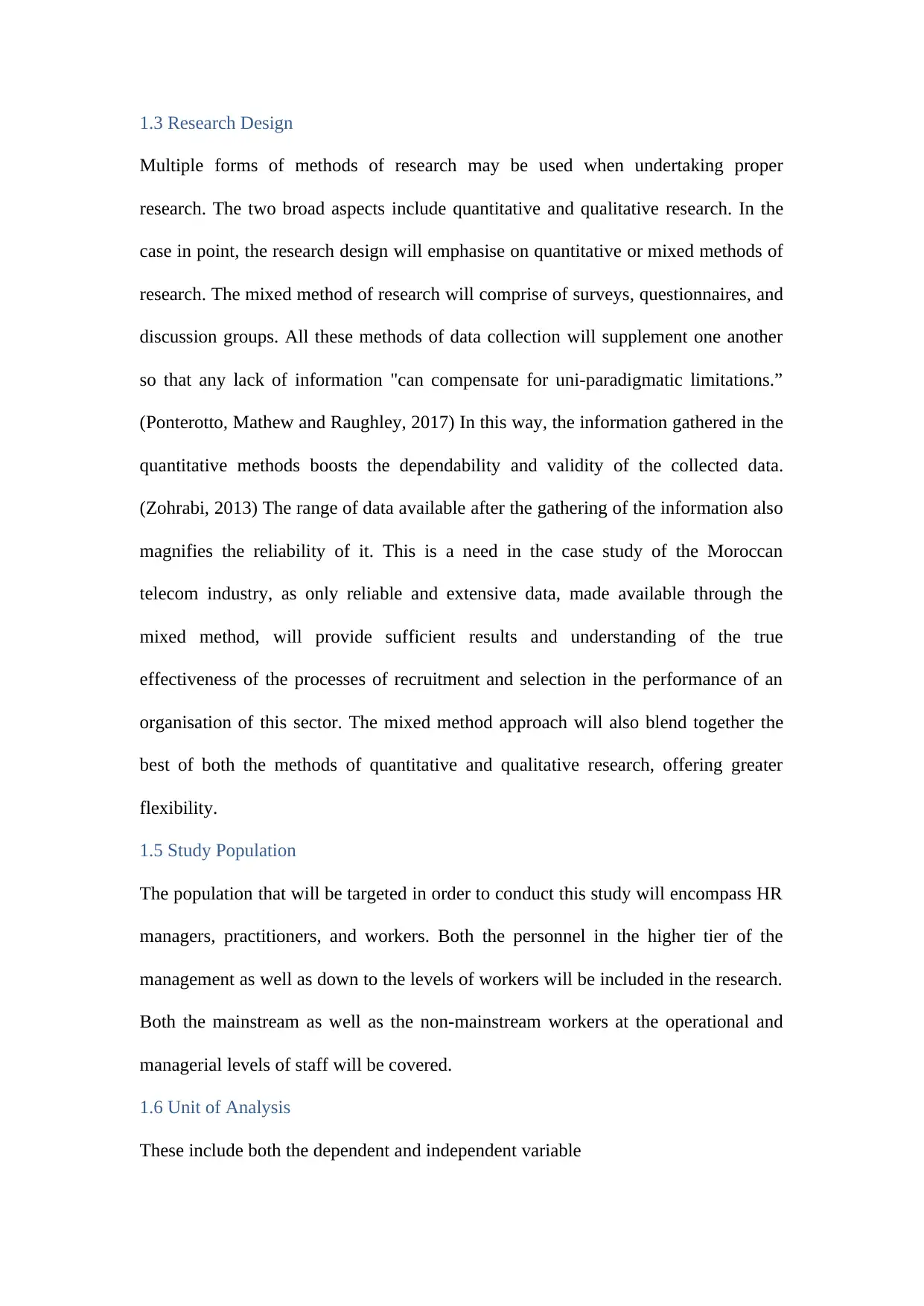
1.3 Research Design
Multiple forms of methods of research may be used when undertaking proper
research. The two broad aspects include quantitative and qualitative research. In the
case in point, the research design will emphasise on quantitative or mixed methods of
research. The mixed method of research will comprise of surveys, questionnaires, and
discussion groups. All these methods of data collection will supplement one another
so that any lack of information "can compensate for uni-paradigmatic limitations.”
(Ponterotto, Mathew and Raughley, 2017) In this way, the information gathered in the
quantitative methods boosts the dependability and validity of the collected data.
(Zohrabi, 2013) The range of data available after the gathering of the information also
magnifies the reliability of it. This is a need in the case study of the Moroccan
telecom industry, as only reliable and extensive data, made available through the
mixed method, will provide sufficient results and understanding of the true
effectiveness of the processes of recruitment and selection in the performance of an
organisation of this sector. The mixed method approach will also blend together the
best of both the methods of quantitative and qualitative research, offering greater
flexibility.
1.5 Study Population
The population that will be targeted in order to conduct this study will encompass HR
managers, practitioners, and workers. Both the personnel in the higher tier of the
management as well as down to the levels of workers will be included in the research.
Both the mainstream as well as the non-mainstream workers at the operational and
managerial levels of staff will be covered.
1.6 Unit of Analysis
These include both the dependent and independent variable
Multiple forms of methods of research may be used when undertaking proper
research. The two broad aspects include quantitative and qualitative research. In the
case in point, the research design will emphasise on quantitative or mixed methods of
research. The mixed method of research will comprise of surveys, questionnaires, and
discussion groups. All these methods of data collection will supplement one another
so that any lack of information "can compensate for uni-paradigmatic limitations.”
(Ponterotto, Mathew and Raughley, 2017) In this way, the information gathered in the
quantitative methods boosts the dependability and validity of the collected data.
(Zohrabi, 2013) The range of data available after the gathering of the information also
magnifies the reliability of it. This is a need in the case study of the Moroccan
telecom industry, as only reliable and extensive data, made available through the
mixed method, will provide sufficient results and understanding of the true
effectiveness of the processes of recruitment and selection in the performance of an
organisation of this sector. The mixed method approach will also blend together the
best of both the methods of quantitative and qualitative research, offering greater
flexibility.
1.5 Study Population
The population that will be targeted in order to conduct this study will encompass HR
managers, practitioners, and workers. Both the personnel in the higher tier of the
management as well as down to the levels of workers will be included in the research.
Both the mainstream as well as the non-mainstream workers at the operational and
managerial levels of staff will be covered.
1.6 Unit of Analysis
These include both the dependent and independent variable
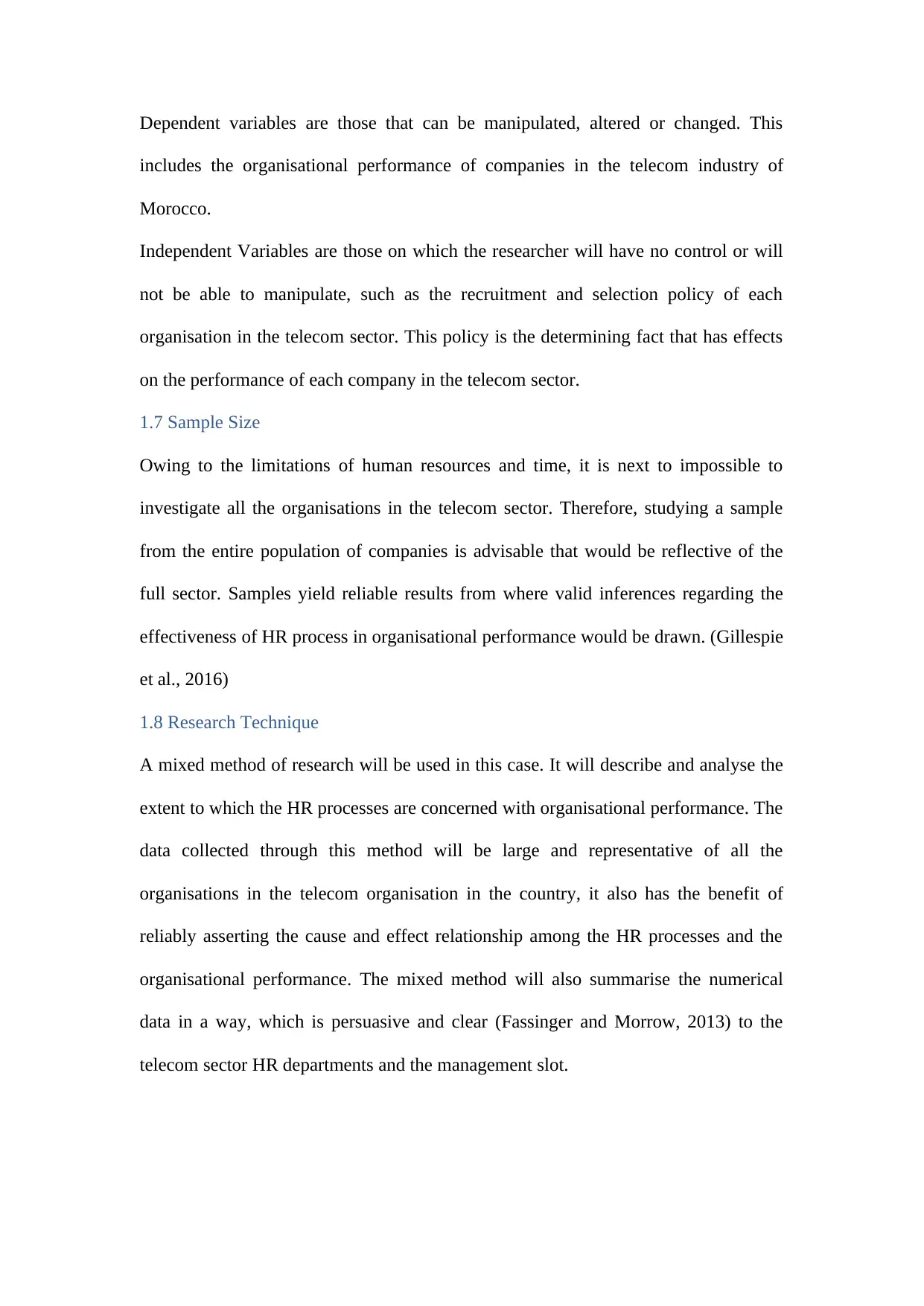
Dependent variables are those that can be manipulated, altered or changed. This
includes the organisational performance of companies in the telecom industry of
Morocco.
Independent Variables are those on which the researcher will have no control or will
not be able to manipulate, such as the recruitment and selection policy of each
organisation in the telecom sector. This policy is the determining fact that has effects
on the performance of each company in the telecom sector.
1.7 Sample Size
Owing to the limitations of human resources and time, it is next to impossible to
investigate all the organisations in the telecom sector. Therefore, studying a sample
from the entire population of companies is advisable that would be reflective of the
full sector. Samples yield reliable results from where valid inferences regarding the
effectiveness of HR process in organisational performance would be drawn. (Gillespie
et al., 2016)
1.8 Research Technique
A mixed method of research will be used in this case. It will describe and analyse the
extent to which the HR processes are concerned with organisational performance. The
data collected through this method will be large and representative of all the
organisations in the telecom organisation in the country, it also has the benefit of
reliably asserting the cause and effect relationship among the HR processes and the
organisational performance. The mixed method will also summarise the numerical
data in a way, which is persuasive and clear (Fassinger and Morrow, 2013) to the
telecom sector HR departments and the management slot.
includes the organisational performance of companies in the telecom industry of
Morocco.
Independent Variables are those on which the researcher will have no control or will
not be able to manipulate, such as the recruitment and selection policy of each
organisation in the telecom sector. This policy is the determining fact that has effects
on the performance of each company in the telecom sector.
1.7 Sample Size
Owing to the limitations of human resources and time, it is next to impossible to
investigate all the organisations in the telecom sector. Therefore, studying a sample
from the entire population of companies is advisable that would be reflective of the
full sector. Samples yield reliable results from where valid inferences regarding the
effectiveness of HR process in organisational performance would be drawn. (Gillespie
et al., 2016)
1.8 Research Technique
A mixed method of research will be used in this case. It will describe and analyse the
extent to which the HR processes are concerned with organisational performance. The
data collected through this method will be large and representative of all the
organisations in the telecom organisation in the country, it also has the benefit of
reliably asserting the cause and effect relationship among the HR processes and the
organisational performance. The mixed method will also summarise the numerical
data in a way, which is persuasive and clear (Fassinger and Morrow, 2013) to the
telecom sector HR departments and the management slot.
⊘ This is a preview!⊘
Do you want full access?
Subscribe today to unlock all pages.

Trusted by 1+ million students worldwide
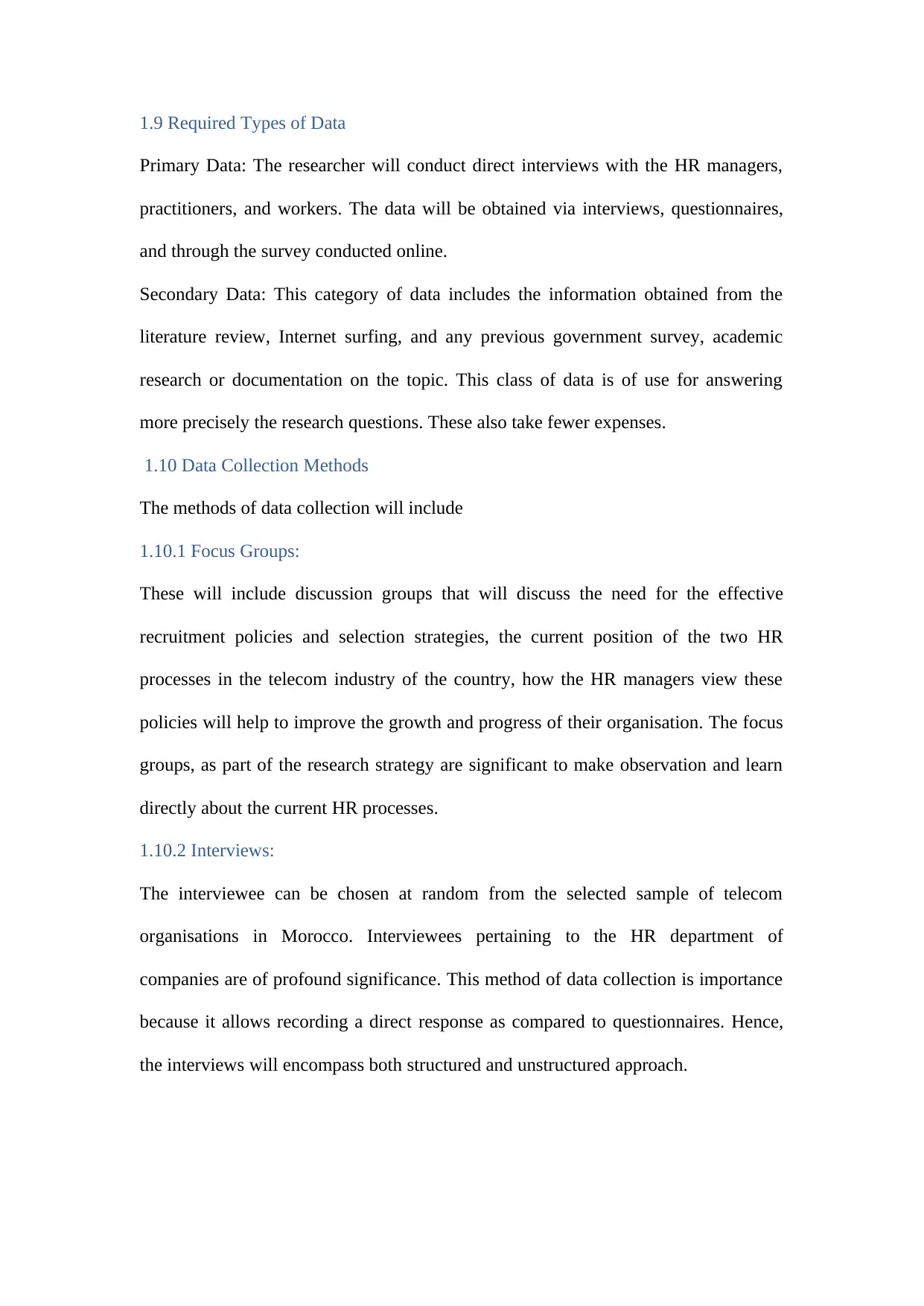
1.9 Required Types of Data
Primary Data: The researcher will conduct direct interviews with the HR managers,
practitioners, and workers. The data will be obtained via interviews, questionnaires,
and through the survey conducted online.
Secondary Data: This category of data includes the information obtained from the
literature review, Internet surfing, and any previous government survey, academic
research or documentation on the topic. This class of data is of use for answering
more precisely the research questions. These also take fewer expenses.
1.10 Data Collection Methods
The methods of data collection will include
1.10.1 Focus Groups:
These will include discussion groups that will discuss the need for the effective
recruitment policies and selection strategies, the current position of the two HR
processes in the telecom industry of the country, how the HR managers view these
policies will help to improve the growth and progress of their organisation. The focus
groups, as part of the research strategy are significant to make observation and learn
directly about the current HR processes.
1.10.2 Interviews:
The interviewee can be chosen at random from the selected sample of telecom
organisations in Morocco. Interviewees pertaining to the HR department of
companies are of profound significance. This method of data collection is importance
because it allows recording a direct response as compared to questionnaires. Hence,
the interviews will encompass both structured and unstructured approach.
Primary Data: The researcher will conduct direct interviews with the HR managers,
practitioners, and workers. The data will be obtained via interviews, questionnaires,
and through the survey conducted online.
Secondary Data: This category of data includes the information obtained from the
literature review, Internet surfing, and any previous government survey, academic
research or documentation on the topic. This class of data is of use for answering
more precisely the research questions. These also take fewer expenses.
1.10 Data Collection Methods
The methods of data collection will include
1.10.1 Focus Groups:
These will include discussion groups that will discuss the need for the effective
recruitment policies and selection strategies, the current position of the two HR
processes in the telecom industry of the country, how the HR managers view these
policies will help to improve the growth and progress of their organisation. The focus
groups, as part of the research strategy are significant to make observation and learn
directly about the current HR processes.
1.10.2 Interviews:
The interviewee can be chosen at random from the selected sample of telecom
organisations in Morocco. Interviewees pertaining to the HR department of
companies are of profound significance. This method of data collection is importance
because it allows recording a direct response as compared to questionnaires. Hence,
the interviews will encompass both structured and unstructured approach.
Paraphrase This Document
Need a fresh take? Get an instant paraphrase of this document with our AI Paraphraser
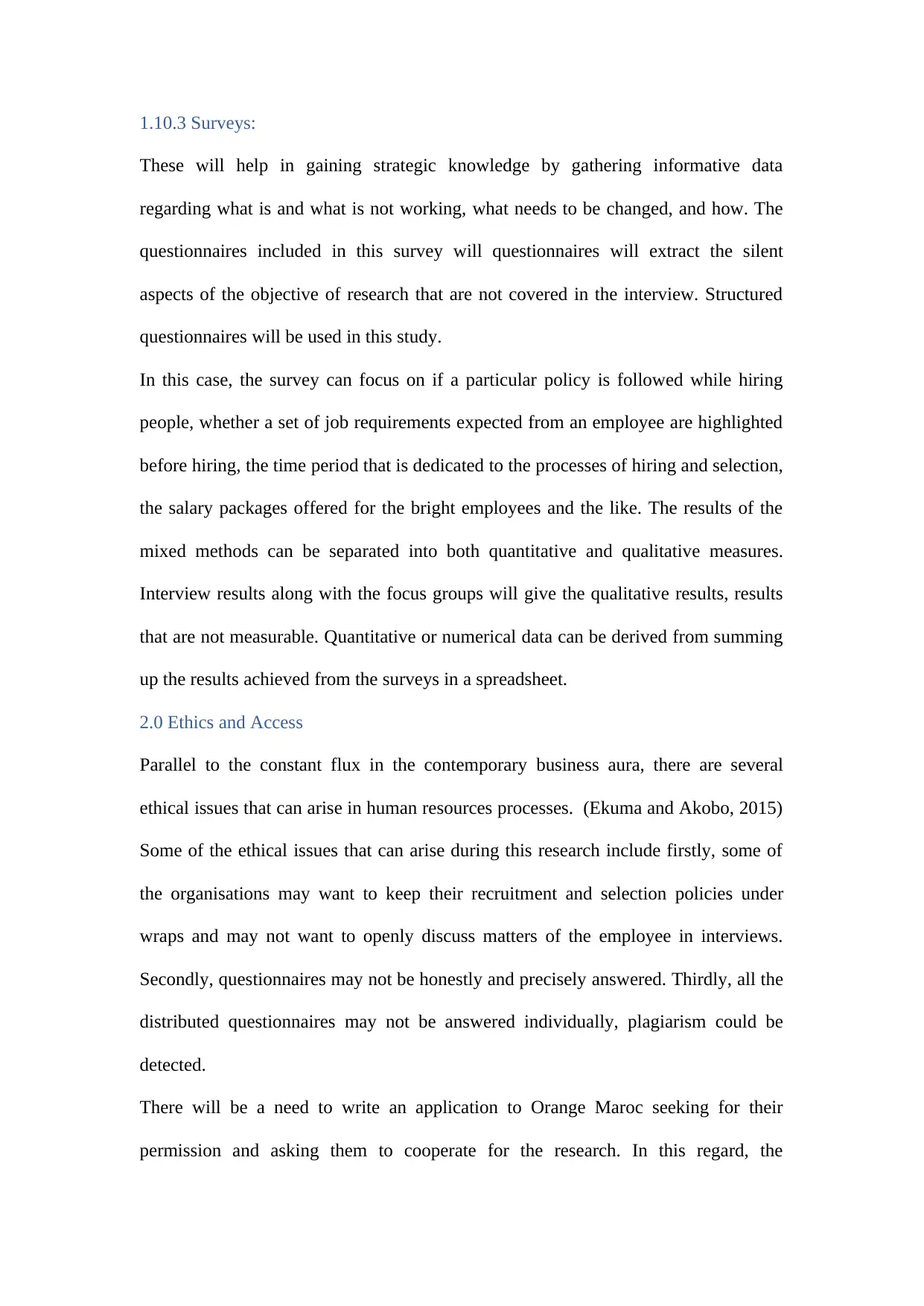
1.10.3 Surveys:
These will help in gaining strategic knowledge by gathering informative data
regarding what is and what is not working, what needs to be changed, and how. The
questionnaires included in this survey will questionnaires will extract the silent
aspects of the objective of research that are not covered in the interview. Structured
questionnaires will be used in this study.
In this case, the survey can focus on if a particular policy is followed while hiring
people, whether a set of job requirements expected from an employee are highlighted
before hiring, the time period that is dedicated to the processes of hiring and selection,
the salary packages offered for the bright employees and the like. The results of the
mixed methods can be separated into both quantitative and qualitative measures.
Interview results along with the focus groups will give the qualitative results, results
that are not measurable. Quantitative or numerical data can be derived from summing
up the results achieved from the surveys in a spreadsheet.
2.0 Ethics and Access
Parallel to the constant flux in the contemporary business aura, there are several
ethical issues that can arise in human resources processes. (Ekuma and Akobo, 2015)
Some of the ethical issues that can arise during this research include firstly, some of
the organisations may want to keep their recruitment and selection policies under
wraps and may not want to openly discuss matters of the employee in interviews.
Secondly, questionnaires may not be honestly and precisely answered. Thirdly, all the
distributed questionnaires may not be answered individually, plagiarism could be
detected.
There will be a need to write an application to Orange Maroc seeking for their
permission and asking them to cooperate for the research. In this regard, the
These will help in gaining strategic knowledge by gathering informative data
regarding what is and what is not working, what needs to be changed, and how. The
questionnaires included in this survey will questionnaires will extract the silent
aspects of the objective of research that are not covered in the interview. Structured
questionnaires will be used in this study.
In this case, the survey can focus on if a particular policy is followed while hiring
people, whether a set of job requirements expected from an employee are highlighted
before hiring, the time period that is dedicated to the processes of hiring and selection,
the salary packages offered for the bright employees and the like. The results of the
mixed methods can be separated into both quantitative and qualitative measures.
Interview results along with the focus groups will give the qualitative results, results
that are not measurable. Quantitative or numerical data can be derived from summing
up the results achieved from the surveys in a spreadsheet.
2.0 Ethics and Access
Parallel to the constant flux in the contemporary business aura, there are several
ethical issues that can arise in human resources processes. (Ekuma and Akobo, 2015)
Some of the ethical issues that can arise during this research include firstly, some of
the organisations may want to keep their recruitment and selection policies under
wraps and may not want to openly discuss matters of the employee in interviews.
Secondly, questionnaires may not be honestly and precisely answered. Thirdly, all the
distributed questionnaires may not be answered individually, plagiarism could be
detected.
There will be a need to write an application to Orange Maroc seeking for their
permission and asking them to cooperate for the research. In this regard, the
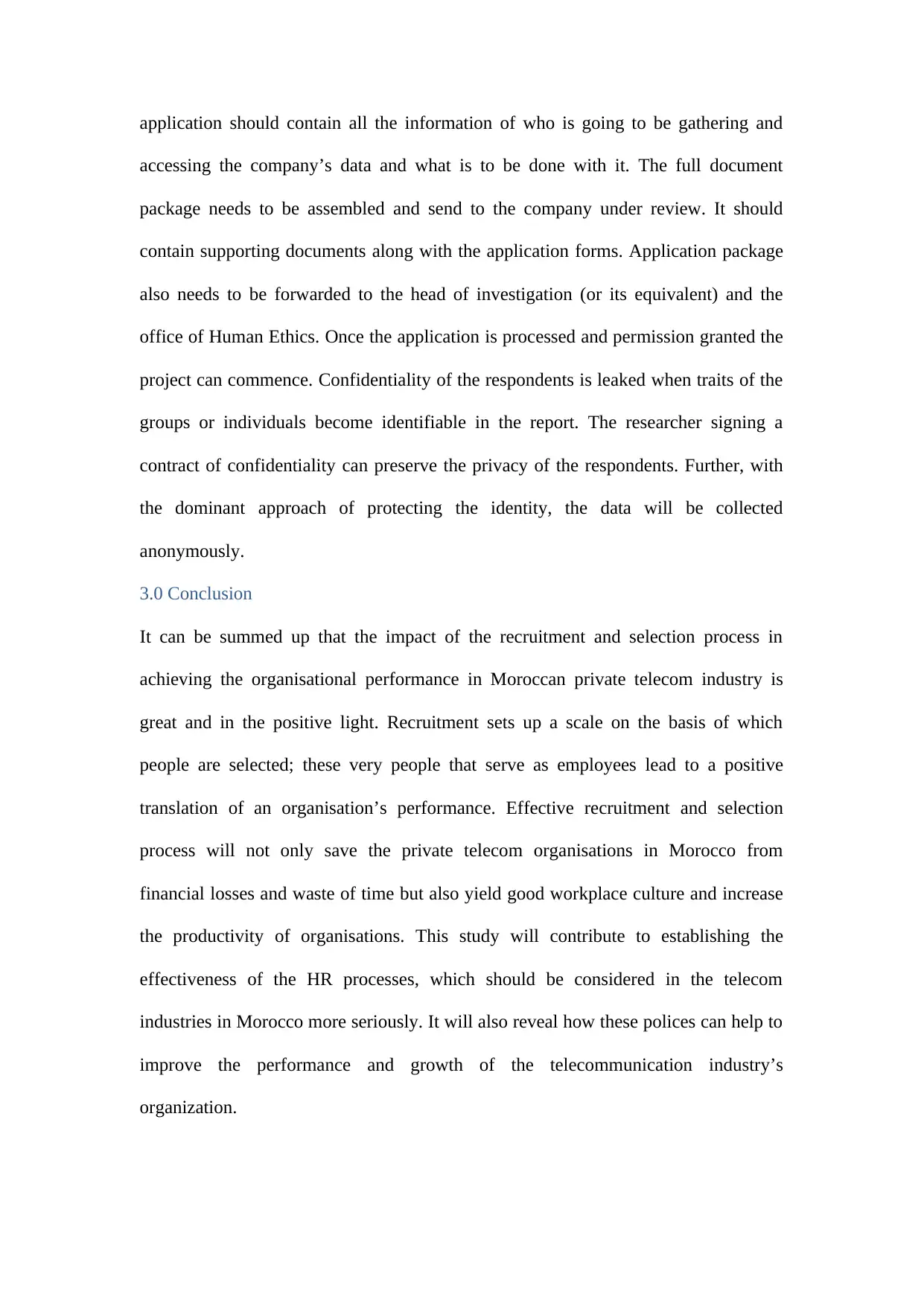
application should contain all the information of who is going to be gathering and
accessing the company’s data and what is to be done with it. The full document
package needs to be assembled and send to the company under review. It should
contain supporting documents along with the application forms. Application package
also needs to be forwarded to the head of investigation (or its equivalent) and the
office of Human Ethics. Once the application is processed and permission granted the
project can commence. Confidentiality of the respondents is leaked when traits of the
groups or individuals become identifiable in the report. The researcher signing a
contract of confidentiality can preserve the privacy of the respondents. Further, with
the dominant approach of protecting the identity, the data will be collected
anonymously.
3.0 Conclusion
It can be summed up that the impact of the recruitment and selection process in
achieving the organisational performance in Moroccan private telecom industry is
great and in the positive light. Recruitment sets up a scale on the basis of which
people are selected; these very people that serve as employees lead to a positive
translation of an organisation’s performance. Effective recruitment and selection
process will not only save the private telecom organisations in Morocco from
financial losses and waste of time but also yield good workplace culture and increase
the productivity of organisations. This study will contribute to establishing the
effectiveness of the HR processes, which should be considered in the telecom
industries in Morocco more seriously. It will also reveal how these polices can help to
improve the performance and growth of the telecommunication industry’s
organization.
accessing the company’s data and what is to be done with it. The full document
package needs to be assembled and send to the company under review. It should
contain supporting documents along with the application forms. Application package
also needs to be forwarded to the head of investigation (or its equivalent) and the
office of Human Ethics. Once the application is processed and permission granted the
project can commence. Confidentiality of the respondents is leaked when traits of the
groups or individuals become identifiable in the report. The researcher signing a
contract of confidentiality can preserve the privacy of the respondents. Further, with
the dominant approach of protecting the identity, the data will be collected
anonymously.
3.0 Conclusion
It can be summed up that the impact of the recruitment and selection process in
achieving the organisational performance in Moroccan private telecom industry is
great and in the positive light. Recruitment sets up a scale on the basis of which
people are selected; these very people that serve as employees lead to a positive
translation of an organisation’s performance. Effective recruitment and selection
process will not only save the private telecom organisations in Morocco from
financial losses and waste of time but also yield good workplace culture and increase
the productivity of organisations. This study will contribute to establishing the
effectiveness of the HR processes, which should be considered in the telecom
industries in Morocco more seriously. It will also reveal how these polices can help to
improve the performance and growth of the telecommunication industry’s
organization.
⊘ This is a preview!⊘
Do you want full access?
Subscribe today to unlock all pages.

Trusted by 1+ million students worldwide
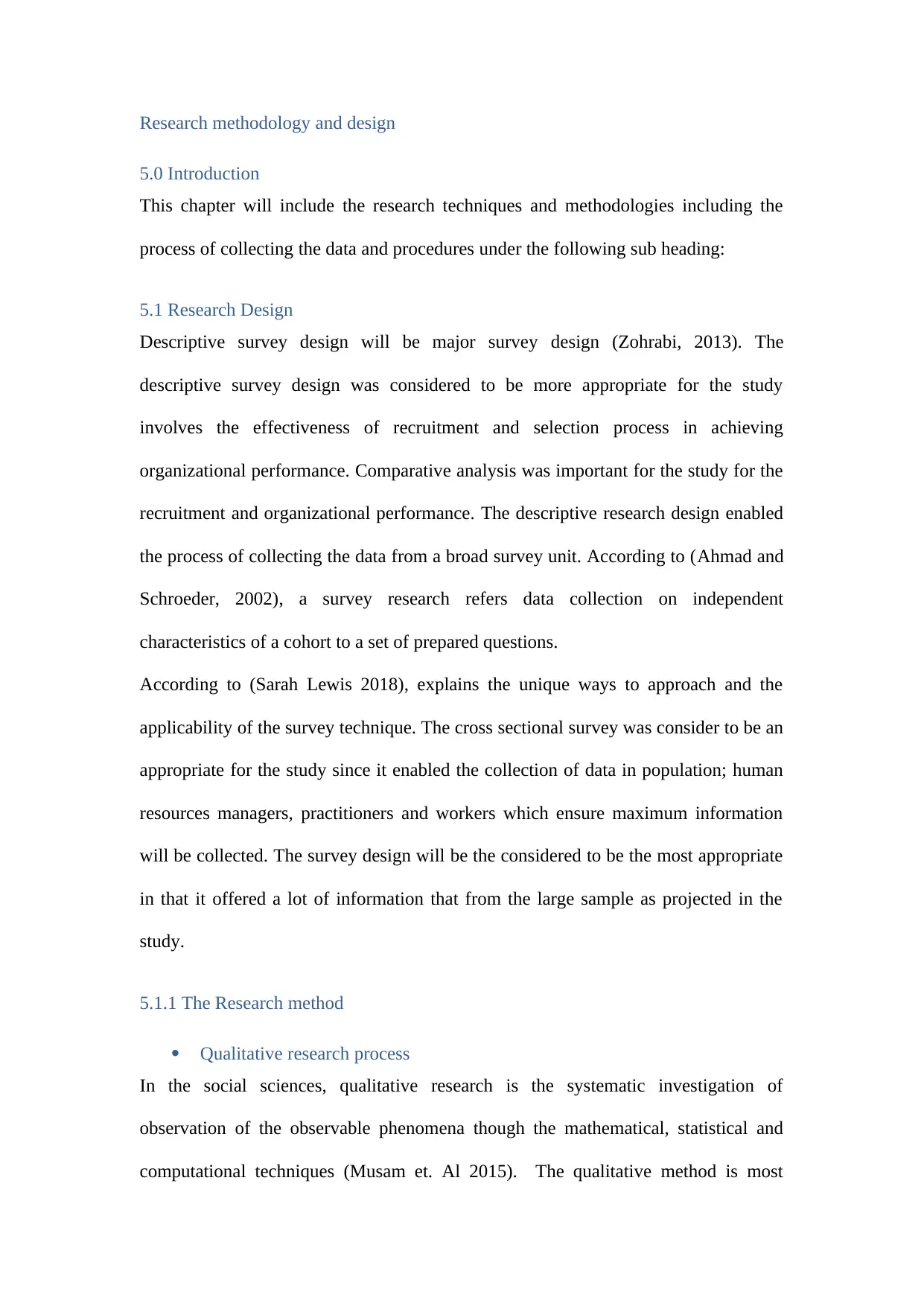
Research methodology and design
5.0 Introduction
This chapter will include the research techniques and methodologies including the
process of collecting the data and procedures under the following sub heading:
5.1 Research Design
Descriptive survey design will be major survey design (Zohrabi, 2013). The
descriptive survey design was considered to be more appropriate for the study
involves the effectiveness of recruitment and selection process in achieving
organizational performance. Comparative analysis was important for the study for the
recruitment and organizational performance. The descriptive research design enabled
the process of collecting the data from a broad survey unit. According to (Ahmad and
Schroeder, 2002), a survey research refers data collection on independent
characteristics of a cohort to a set of prepared questions.
According to (Sarah Lewis 2018), explains the unique ways to approach and the
applicability of the survey technique. The cross sectional survey was consider to be an
appropriate for the study since it enabled the collection of data in population; human
resources managers, practitioners and workers which ensure maximum information
will be collected. The survey design will be the considered to be the most appropriate
in that it offered a lot of information that from the large sample as projected in the
study.
5.1.1 The Research method
Qualitative research process
In the social sciences, qualitative research is the systematic investigation of
observation of the observable phenomena though the mathematical, statistical and
computational techniques (Musam et. Al 2015). The qualitative method is most
5.0 Introduction
This chapter will include the research techniques and methodologies including the
process of collecting the data and procedures under the following sub heading:
5.1 Research Design
Descriptive survey design will be major survey design (Zohrabi, 2013). The
descriptive survey design was considered to be more appropriate for the study
involves the effectiveness of recruitment and selection process in achieving
organizational performance. Comparative analysis was important for the study for the
recruitment and organizational performance. The descriptive research design enabled
the process of collecting the data from a broad survey unit. According to (Ahmad and
Schroeder, 2002), a survey research refers data collection on independent
characteristics of a cohort to a set of prepared questions.
According to (Sarah Lewis 2018), explains the unique ways to approach and the
applicability of the survey technique. The cross sectional survey was consider to be an
appropriate for the study since it enabled the collection of data in population; human
resources managers, practitioners and workers which ensure maximum information
will be collected. The survey design will be the considered to be the most appropriate
in that it offered a lot of information that from the large sample as projected in the
study.
5.1.1 The Research method
Qualitative research process
In the social sciences, qualitative research is the systematic investigation of
observation of the observable phenomena though the mathematical, statistical and
computational techniques (Musam et. Al 2015). The qualitative method is most
Paraphrase This Document
Need a fresh take? Get an instant paraphrase of this document with our AI Paraphraser
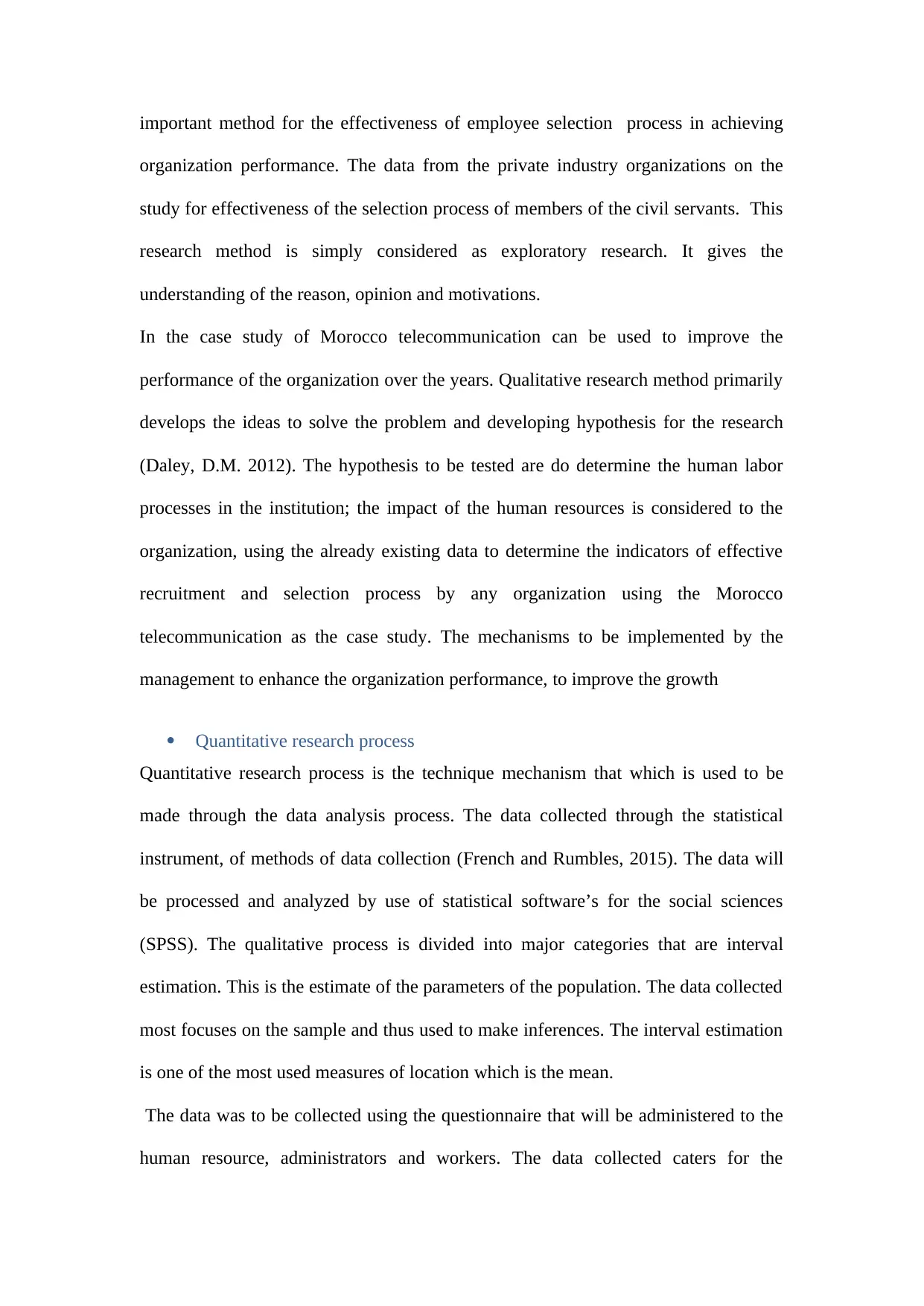
important method for the effectiveness of employee selection process in achieving
organization performance. The data from the private industry organizations on the
study for effectiveness of the selection process of members of the civil servants. This
research method is simply considered as exploratory research. It gives the
understanding of the reason, opinion and motivations.
In the case study of Morocco telecommunication can be used to improve the
performance of the organization over the years. Qualitative research method primarily
develops the ideas to solve the problem and developing hypothesis for the research
(Daley, D.M. 2012). The hypothesis to be tested are do determine the human labor
processes in the institution; the impact of the human resources is considered to the
organization, using the already existing data to determine the indicators of effective
recruitment and selection process by any organization using the Morocco
telecommunication as the case study. The mechanisms to be implemented by the
management to enhance the organization performance, to improve the growth
Quantitative research process
Quantitative research process is the technique mechanism that which is used to be
made through the data analysis process. The data collected through the statistical
instrument, of methods of data collection (French and Rumbles, 2015). The data will
be processed and analyzed by use of statistical software’s for the social sciences
(SPSS). The qualitative process is divided into major categories that are interval
estimation. This is the estimate of the parameters of the population. The data collected
most focuses on the sample and thus used to make inferences. The interval estimation
is one of the most used measures of location which is the mean.
The data was to be collected using the questionnaire that will be administered to the
human resource, administrators and workers. The data collected caters for the
organization performance. The data from the private industry organizations on the
study for effectiveness of the selection process of members of the civil servants. This
research method is simply considered as exploratory research. It gives the
understanding of the reason, opinion and motivations.
In the case study of Morocco telecommunication can be used to improve the
performance of the organization over the years. Qualitative research method primarily
develops the ideas to solve the problem and developing hypothesis for the research
(Daley, D.M. 2012). The hypothesis to be tested are do determine the human labor
processes in the institution; the impact of the human resources is considered to the
organization, using the already existing data to determine the indicators of effective
recruitment and selection process by any organization using the Morocco
telecommunication as the case study. The mechanisms to be implemented by the
management to enhance the organization performance, to improve the growth
Quantitative research process
Quantitative research process is the technique mechanism that which is used to be
made through the data analysis process. The data collected through the statistical
instrument, of methods of data collection (French and Rumbles, 2015). The data will
be processed and analyzed by use of statistical software’s for the social sciences
(SPSS). The qualitative process is divided into major categories that are interval
estimation. This is the estimate of the parameters of the population. The data collected
most focuses on the sample and thus used to make inferences. The interval estimation
is one of the most used measures of location which is the mean.
The data was to be collected using the questionnaire that will be administered to the
human resource, administrators and workers. The data collected caters for the
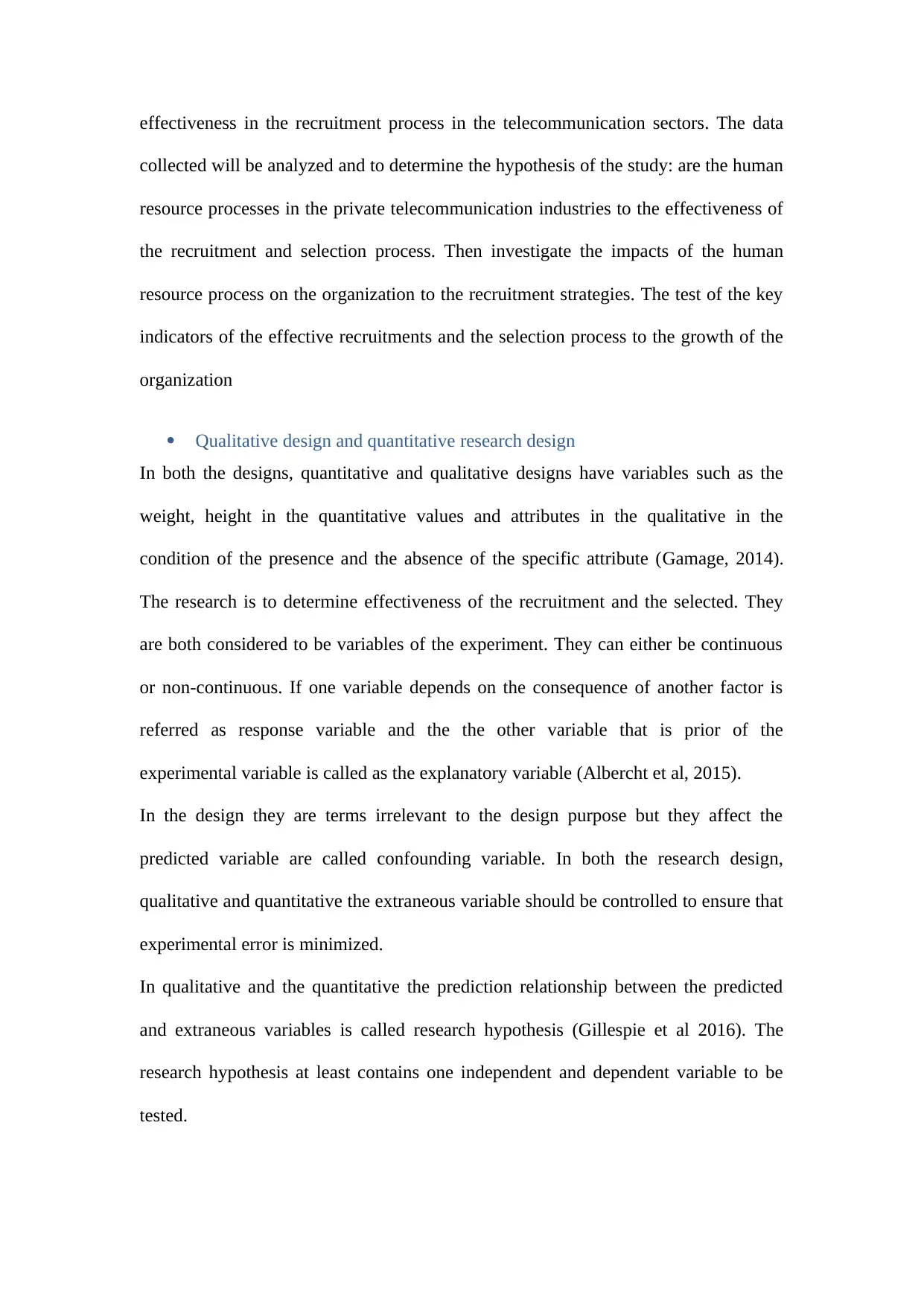
effectiveness in the recruitment process in the telecommunication sectors. The data
collected will be analyzed and to determine the hypothesis of the study: are the human
resource processes in the private telecommunication industries to the effectiveness of
the recruitment and selection process. Then investigate the impacts of the human
resource process on the organization to the recruitment strategies. The test of the key
indicators of the effective recruitments and the selection process to the growth of the
organization
Qualitative design and quantitative research design
In both the designs, quantitative and qualitative designs have variables such as the
weight, height in the quantitative values and attributes in the qualitative in the
condition of the presence and the absence of the specific attribute (Gamage, 2014).
The research is to determine effectiveness of the recruitment and the selected. They
are both considered to be variables of the experiment. They can either be continuous
or non-continuous. If one variable depends on the consequence of another factor is
referred as response variable and the the other variable that is prior of the
experimental variable is called as the explanatory variable (Albercht et al, 2015).
In the design they are terms irrelevant to the design purpose but they affect the
predicted variable are called confounding variable. In both the research design,
qualitative and quantitative the extraneous variable should be controlled to ensure that
experimental error is minimized.
In qualitative and the quantitative the prediction relationship between the predicted
and extraneous variables is called research hypothesis (Gillespie et al 2016). The
research hypothesis at least contains one independent and dependent variable to be
tested.
collected will be analyzed and to determine the hypothesis of the study: are the human
resource processes in the private telecommunication industries to the effectiveness of
the recruitment and selection process. Then investigate the impacts of the human
resource process on the organization to the recruitment strategies. The test of the key
indicators of the effective recruitments and the selection process to the growth of the
organization
Qualitative design and quantitative research design
In both the designs, quantitative and qualitative designs have variables such as the
weight, height in the quantitative values and attributes in the qualitative in the
condition of the presence and the absence of the specific attribute (Gamage, 2014).
The research is to determine effectiveness of the recruitment and the selected. They
are both considered to be variables of the experiment. They can either be continuous
or non-continuous. If one variable depends on the consequence of another factor is
referred as response variable and the the other variable that is prior of the
experimental variable is called as the explanatory variable (Albercht et al, 2015).
In the design they are terms irrelevant to the design purpose but they affect the
predicted variable are called confounding variable. In both the research design,
qualitative and quantitative the extraneous variable should be controlled to ensure that
experimental error is minimized.
In qualitative and the quantitative the prediction relationship between the predicted
and extraneous variables is called research hypothesis (Gillespie et al 2016). The
research hypothesis at least contains one independent and dependent variable to be
tested.
⊘ This is a preview!⊘
Do you want full access?
Subscribe today to unlock all pages.

Trusted by 1+ million students worldwide
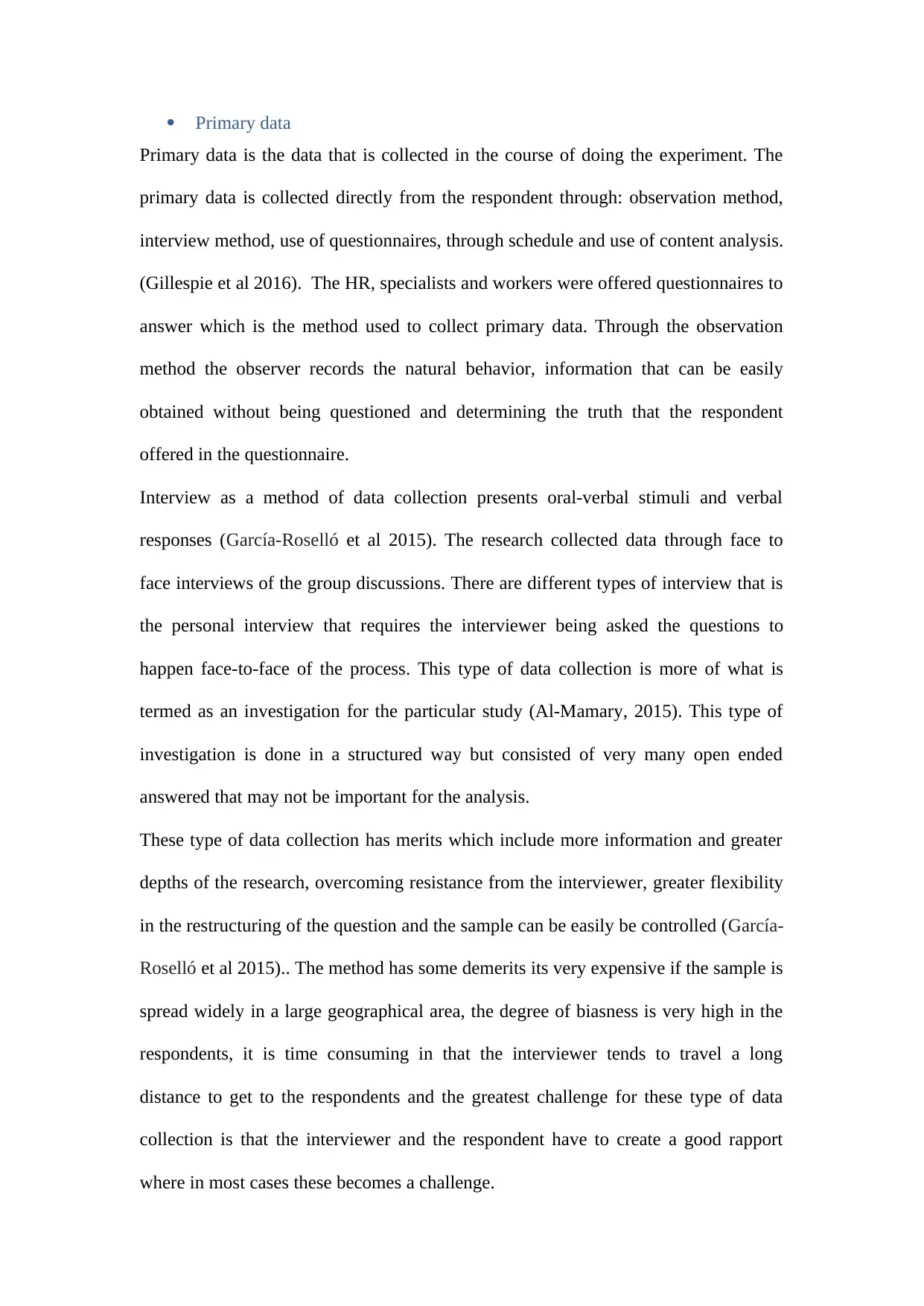
Primary data
Primary data is the data that is collected in the course of doing the experiment. The
primary data is collected directly from the respondent through: observation method,
interview method, use of questionnaires, through schedule and use of content analysis.
(Gillespie et al 2016). The HR, specialists and workers were offered questionnaires to
answer which is the method used to collect primary data. Through the observation
method the observer records the natural behavior, information that can be easily
obtained without being questioned and determining the truth that the respondent
offered in the questionnaire.
Interview as a method of data collection presents oral-verbal stimuli and verbal
responses (García‐Roselló et al 2015). The research collected data through face to
face interviews of the group discussions. There are different types of interview that is
the personal interview that requires the interviewer being asked the questions to
happen face-to-face of the process. This type of data collection is more of what is
termed as an investigation for the particular study (Al-Mamary, 2015). This type of
investigation is done in a structured way but consisted of very many open ended
answered that may not be important for the analysis.
These type of data collection has merits which include more information and greater
depths of the research, overcoming resistance from the interviewer, greater flexibility
in the restructuring of the question and the sample can be easily be controlled (García‐
Roselló et al 2015).. The method has some demerits its very expensive if the sample is
spread widely in a large geographical area, the degree of biasness is very high in the
respondents, it is time consuming in that the interviewer tends to travel a long
distance to get to the respondents and the greatest challenge for these type of data
collection is that the interviewer and the respondent have to create a good rapport
where in most cases these becomes a challenge.
Primary data is the data that is collected in the course of doing the experiment. The
primary data is collected directly from the respondent through: observation method,
interview method, use of questionnaires, through schedule and use of content analysis.
(Gillespie et al 2016). The HR, specialists and workers were offered questionnaires to
answer which is the method used to collect primary data. Through the observation
method the observer records the natural behavior, information that can be easily
obtained without being questioned and determining the truth that the respondent
offered in the questionnaire.
Interview as a method of data collection presents oral-verbal stimuli and verbal
responses (García‐Roselló et al 2015). The research collected data through face to
face interviews of the group discussions. There are different types of interview that is
the personal interview that requires the interviewer being asked the questions to
happen face-to-face of the process. This type of data collection is more of what is
termed as an investigation for the particular study (Al-Mamary, 2015). This type of
investigation is done in a structured way but consisted of very many open ended
answered that may not be important for the analysis.
These type of data collection has merits which include more information and greater
depths of the research, overcoming resistance from the interviewer, greater flexibility
in the restructuring of the question and the sample can be easily be controlled (García‐
Roselló et al 2015).. The method has some demerits its very expensive if the sample is
spread widely in a large geographical area, the degree of biasness is very high in the
respondents, it is time consuming in that the interviewer tends to travel a long
distance to get to the respondents and the greatest challenge for these type of data
collection is that the interviewer and the respondent have to create a good rapport
where in most cases these becomes a challenge.
Paraphrase This Document
Need a fresh take? Get an instant paraphrase of this document with our AI Paraphraser
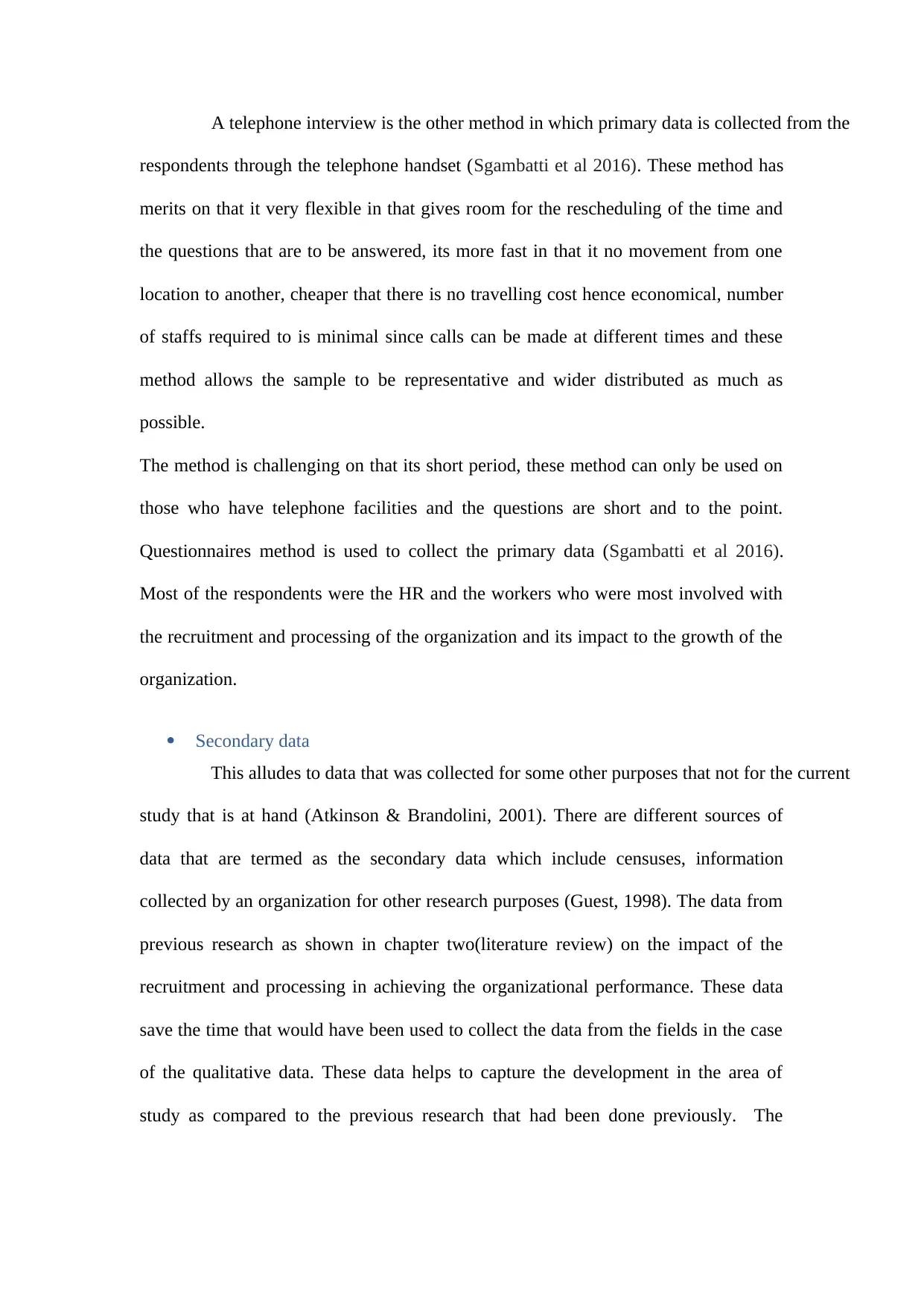
A telephone interview is the other method in which primary data is collected from the
respondents through the telephone handset (Sgambatti et al 2016). These method has
merits on that it very flexible in that gives room for the rescheduling of the time and
the questions that are to be answered, its more fast in that it no movement from one
location to another, cheaper that there is no travelling cost hence economical, number
of staffs required to is minimal since calls can be made at different times and these
method allows the sample to be representative and wider distributed as much as
possible.
The method is challenging on that its short period, these method can only be used on
those who have telephone facilities and the questions are short and to the point.
Questionnaires method is used to collect the primary data (Sgambatti et al 2016).
Most of the respondents were the HR and the workers who were most involved with
the recruitment and processing of the organization and its impact to the growth of the
organization.
Secondary data
This alludes to data that was collected for some other purposes that not for the current
study that is at hand (Atkinson & Brandolini, 2001). There are different sources of
data that are termed as the secondary data which include censuses, information
collected by an organization for other research purposes (Guest, 1998). The data from
previous research as shown in chapter two(literature review) on the impact of the
recruitment and processing in achieving the organizational performance. These data
save the time that would have been used to collect the data from the fields in the case
of the qualitative data. These data helps to capture the development in the area of
study as compared to the previous research that had been done previously. The
respondents through the telephone handset (Sgambatti et al 2016). These method has
merits on that it very flexible in that gives room for the rescheduling of the time and
the questions that are to be answered, its more fast in that it no movement from one
location to another, cheaper that there is no travelling cost hence economical, number
of staffs required to is minimal since calls can be made at different times and these
method allows the sample to be representative and wider distributed as much as
possible.
The method is challenging on that its short period, these method can only be used on
those who have telephone facilities and the questions are short and to the point.
Questionnaires method is used to collect the primary data (Sgambatti et al 2016).
Most of the respondents were the HR and the workers who were most involved with
the recruitment and processing of the organization and its impact to the growth of the
organization.
Secondary data
This alludes to data that was collected for some other purposes that not for the current
study that is at hand (Atkinson & Brandolini, 2001). There are different sources of
data that are termed as the secondary data which include censuses, information
collected by an organization for other research purposes (Guest, 1998). The data from
previous research as shown in chapter two(literature review) on the impact of the
recruitment and processing in achieving the organizational performance. These data
save the time that would have been used to collect the data from the fields in the case
of the qualitative data. These data helps to capture the development in the area of
study as compared to the previous research that had been done previously. The
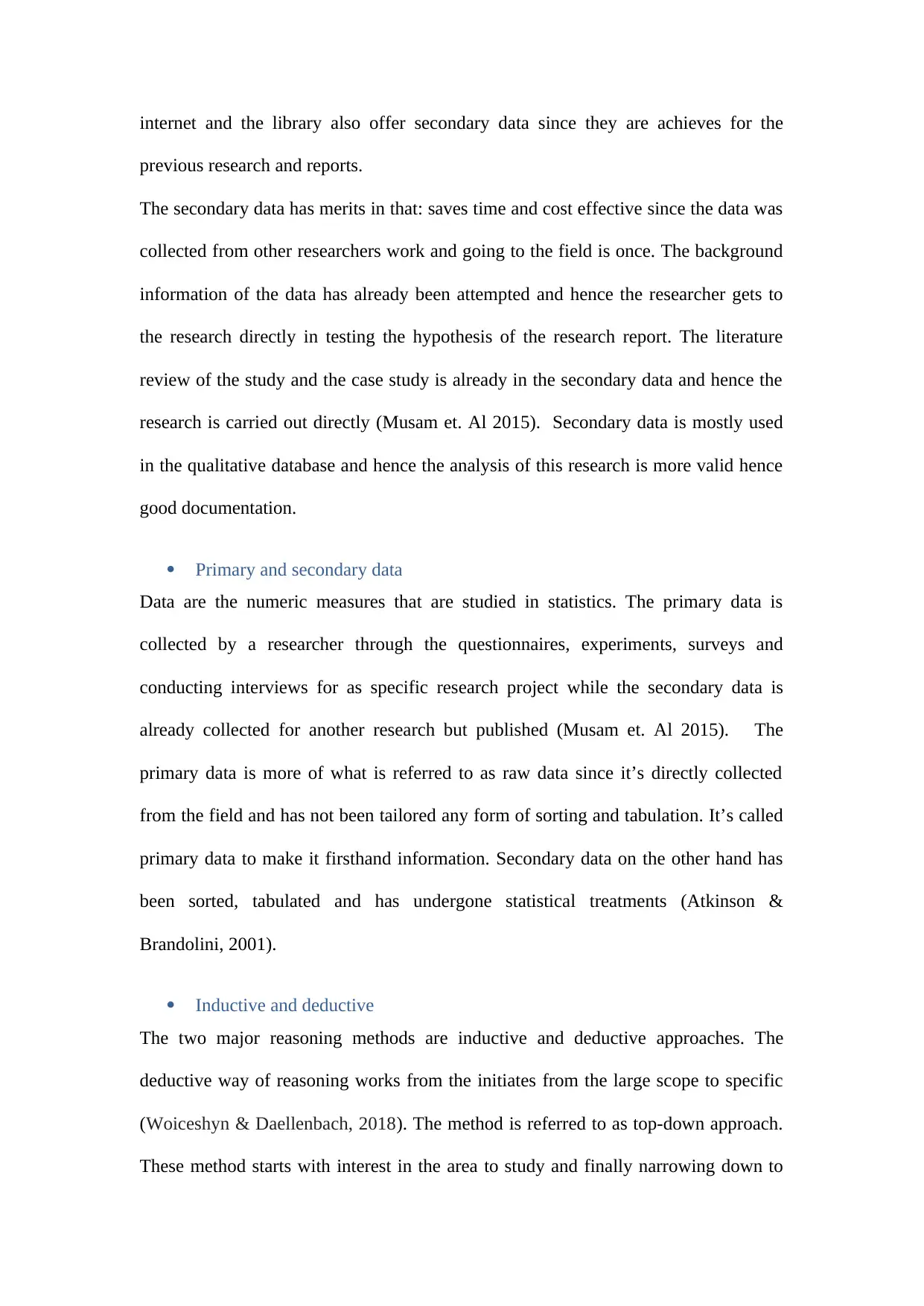
internet and the library also offer secondary data since they are achieves for the
previous research and reports.
The secondary data has merits in that: saves time and cost effective since the data was
collected from other researchers work and going to the field is once. The background
information of the data has already been attempted and hence the researcher gets to
the research directly in testing the hypothesis of the research report. The literature
review of the study and the case study is already in the secondary data and hence the
research is carried out directly (Musam et. Al 2015). Secondary data is mostly used
in the qualitative database and hence the analysis of this research is more valid hence
good documentation.
Primary and secondary data
Data are the numeric measures that are studied in statistics. The primary data is
collected by a researcher through the questionnaires, experiments, surveys and
conducting interviews for as specific research project while the secondary data is
already collected for another research but published (Musam et. Al 2015). The
primary data is more of what is referred to as raw data since it’s directly collected
from the field and has not been tailored any form of sorting and tabulation. It’s called
primary data to make it firsthand information. Secondary data on the other hand has
been sorted, tabulated and has undergone statistical treatments (Atkinson &
Brandolini, 2001).
Inductive and deductive
The two major reasoning methods are inductive and deductive approaches. The
deductive way of reasoning works from the initiates from the large scope to specific
(Woiceshyn & Daellenbach, 2018). The method is referred to as top-down approach.
These method starts with interest in the area to study and finally narrowing down to
previous research and reports.
The secondary data has merits in that: saves time and cost effective since the data was
collected from other researchers work and going to the field is once. The background
information of the data has already been attempted and hence the researcher gets to
the research directly in testing the hypothesis of the research report. The literature
review of the study and the case study is already in the secondary data and hence the
research is carried out directly (Musam et. Al 2015). Secondary data is mostly used
in the qualitative database and hence the analysis of this research is more valid hence
good documentation.
Primary and secondary data
Data are the numeric measures that are studied in statistics. The primary data is
collected by a researcher through the questionnaires, experiments, surveys and
conducting interviews for as specific research project while the secondary data is
already collected for another research but published (Musam et. Al 2015). The
primary data is more of what is referred to as raw data since it’s directly collected
from the field and has not been tailored any form of sorting and tabulation. It’s called
primary data to make it firsthand information. Secondary data on the other hand has
been sorted, tabulated and has undergone statistical treatments (Atkinson &
Brandolini, 2001).
Inductive and deductive
The two major reasoning methods are inductive and deductive approaches. The
deductive way of reasoning works from the initiates from the large scope to specific
(Woiceshyn & Daellenbach, 2018). The method is referred to as top-down approach.
These method starts with interest in the area to study and finally narrowing down to
⊘ This is a preview!⊘
Do you want full access?
Subscribe today to unlock all pages.

Trusted by 1+ million students worldwide
1 out of 36
Related Documents
Your All-in-One AI-Powered Toolkit for Academic Success.
+13062052269
info@desklib.com
Available 24*7 on WhatsApp / Email
![[object Object]](/_next/static/media/star-bottom.7253800d.svg)
Unlock your academic potential
Copyright © 2020–2025 A2Z Services. All Rights Reserved. Developed and managed by ZUCOL.





